Top>Opinion>Mitigating River Disasters and Creating a Rich Water Environment —Technological and Social Infrastructure Development by Universities—
 Index
Index
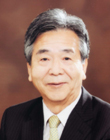
Shoji Fukuoka【profile】
Mitigating River Disasters and Creating a Rich Water Environment
—Technological and Social Infrastructure Development by Universities—
Shoji Fukuoka
Professor, Research and Development Initiatives, Chuo University
Areas of Specialization: River Engineering, Hydraulic Engineering, Disaster Prevention and Environment, Civil Planning
1. Introduction
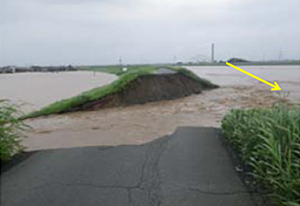
Photograph 1: Yabe River breaking through embankment after heavy rainfall in north Kyushu, July 2012
Rivers occupy expansive spaces of water and vegetation, enriching people’s daily lives, and providing places for rest and recreation. They are also invaluable for the growth, habitation and breeding of wildlife. On the other hand, due to its natural and geographical conditions, Japan is prone to water disasters. Heavy rainfall can cause rivers to flood, at times causing major inundation and devastating damage, threatening people’s daily lives.
The missions of the Fukuoka Unit of Chuo University’s Research and Development Initiatives are to conduct research and development into disaster-prevention and environmental technologies and to apply those technologies in the field, with the aim of building a rich society that can enjoy these benefits of rivers in safety and with peace of mind. The Unit’s research focuses on the development of highly safe flood control technologies and of river channel design that achieves harmony between flood control and environmental concerns. These will be described in more detail below. The Fukuoka Unit is a research group comprising six full-time research engineers and many doctoral students. While pursuing basic research, the Unit’s researchers also actively participate in joint research projects with the aid of external funding from government agencies and private-sector corporations. In this way, the Unit is contributing to the development of Japan’s social infrastructure through the development of new technologies.
2. Development of Highly Safe Flood Control Technologies
2.1 Use of Flood Flow Surface Profiles to Elucidate Actual Flood Flow and Develop Rational Structure Design and River Management Technologies
During a flood, the sediment that forms the cross-section of a river moves, causing the shape of riverbed to change. Variations in riverbed and riverbank profiles cause many difficult problems for the management of river structures such as embankments and channels. As shown in Figure 1, to shed light on these issues, the Fukuoka Unit observed the temporal changes in the surface profiles of flood flow, and found that, when those observations almost coincide with the results of water surface profiles obtained through the flood discharge-bottom velocity computation (BVC) method, then the results of the corresponding bed variation analysis will show the actual forms of the riverbed during the flood. The Unit’s success in making the structures under the surface of flood flows visible in this way has provided rational methods of river management. The patient accumulation of flood observations and analyses has revealed that bed variations are strongly reflected in the temporal changes in water surface profiles and that, if these temporal changes in the observed water surface profiles can be explained in an analytical manner, the hydraulic phenomena taking place under the surface can also be almost completely explained. This has led to major progress in the field of river technology.
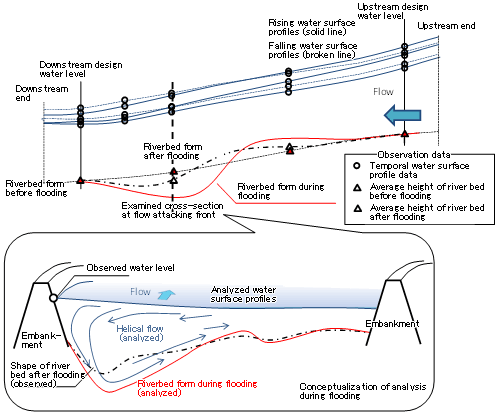
Figure 1. Visualization of the internal structure of flood flow through the flood discharge-bottom velocity computation (BVC) method, based on water surface profile temporal sequence data
Further, bed variations due to local scours and depositions developing around river structures, which are caused by the existence of those structures, can lead to their destruction. Until now, however, there had been no truly effective analysis technologies or methods to assist in the design of such structures. The Fukuoka Unit created a new quasi-three-dimensional numerical analysis model that took into account the characteristic vertical distributions of vorticity and non-hydrostatic pressure intensity caused by the interaction of the structures and water flow, and proposed methods for the design of river structures such as levees, groins, weirs and bridge footings that use this model. These methods are being used for disaster-forecasting and design technologies, and they are improving the safety of river flood controls.
2.2 Development of Methods for Assessment of Embankment Destruction Risk and Their Use in Deciding River Project Order
Embankments are the most important facilities built in and along rivers in Japan. And yet, despite this, for a variety of reasons, including that Japan’s embankments are built in low-lying areas that were originally floodplains, and that, those embankments having been damaged and repaired repeatedly, their soil structure is hard to ascertain, it has been difficult to check embankments sufficiently for sliding or seepage failure during floods. In recent years, however, embankment soil boring data has been collected and, thanks to advances in analytical technologies, it is now possible to calculate the destruction risk of embankments in a flood. Using the boring data, the Unit applied reliability analysis to average soil parameters and probabilistic variables, and proposed methods for calculating the probability of sliding and seepage failure to embankments. This makes it possible to estimate the risk of embankment destruction on our nation’s rivers and consider the quality of those embankments from technical perspectives. Further, using these estimation methods, the Unit has formulated fundamental concepts about river improvement, such as the order in which rivers should be improved and in what ways, places where reinforcement of embankments is needed, and whether priority should be given to the improvement of embankments or to that of river channels. In this way, the Unit has provided directions for the development of embankment management and river improvement technologies, and is making major contributions to the mitigation of river disasters.
3. River Development Going Forward—River Channel Design That Achieves Harmony between Flood Control and Environmental Concerns
Going forward, social infrastructure development will need to achieve harmony between safety and the environment. In terms of river infrastructure, the main challenge will be river channel design that allows easy management, while also maintaining a balance between safety and the environment. Many of the midstream and downstream sections of large rivers have compound cross-sections comprising both low-water and high-water channels. Due to the lowering of the riverbed in the low-water sections and thick vegetation on the high-water sections, these rivers are unable to transport floodwaters downstream sufficiently. As a result, we were seeing the degradation of both flood controls and the riverine environment in many river channels.
Based on the belief that, to improve these compound-channel rivers that have both flood-control and environmental problems, the rivers’ cross-sectional forms need to be improved, the Fukuoka Unit engaged in technological development aimed at channel cross-sections that achieve harmony between flood control and the environment. Highly natural rivers generally have a cross-sectional form in the shape of a ship’s bottom (ship-bottom-shaped cross-section). Upon technical consideration of the ship-bottom-shaped cross-section, the Unit found that it would be possible to improve the flood-control and environmental issues of compound-channel rivers. For example, undesirable water level, flow speed and other flood flow factors are greatly improved in ship-bottom-shaped channels compared to compound channels, and it is also easier to control vegetation in the river channels. The Unit then presented design methods that were implemented in the field.
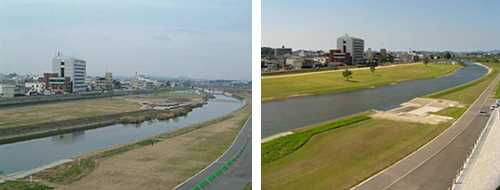
Photograph 2. The Onga River channel was reshaped from a compound channel to a ship-bottom-shaped channel (Left: before reshaping; Right: After reshaping)
The water’s edges of rivers have important functions for both flood control and the environment. The strong attack of flow that are generated against the bank-line during a flood exposes embankments at risk from breaching. River bank-lines are ordinarily formed by sandbars, but the strong influence of human activity has caused these sandbars to shrink or disappear altogether. Through analysis and field testing, the Unit developed embankment protection works using large stones on sandbars. Restoring the sandbar that already existed and placing large stones at the flow attacking front of the sandbar to protect it softens the strong water impact during floods and guides the main stream of the flood alongside of the sandbar and into the center of the river channel.
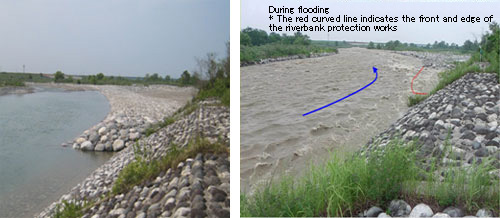
Photograph 3. Construction of embankment sandbar protection works with large rocks on Joganji River, and water flow during flood
These riverbank protective works constructed on rivers managed by the Ministry of Land, Infrastructure, Transport and Tourism have been very effective in terms of both flood control and the environment, and they have also proved very easy to manage. In 2014, this technological development was awarded the Outstanding Civil Engineering Achievement Award (OCEA Award) Group I. This was the first time in the history of the Civil Engineering Award, which was established in 1965, that it was awarded to the outcomes of university research. The receipt of this award presented an opportunity to convey to the wider community the great potential and importance of university-based R&D in the area of social infrastructure development.
4. Conclusion
Climate change is resulting in the growth in frequency and scale of heavy rainfall, which in turn is causing the intensification of external forces of floods. These circumstances have increased the potential for serious damage from flooding. Flood control adaptation measures in response to this heightened risk of flood damage cannot be achieved through river technologies alone; collaboration and cooperation with all sectors is needed in the consideration of measures for the mitigation of such damage. In response to these important and urgent challenges, the Fukuoka Unit is ardently pursuing research not only into the technological aspects, but also into the best technology policies and systems, including socio-economic systems.
Related Links
-
Shoji Fukuoka
Professor, Research and Development Initiatives, Chuo University
Areas of Specialization: River Engineering, Hydraulic Engineering, Disaster Prevention and Environment, Civil Planning -
Professor Shoji Fukuoka was born in Hokkaido in 1942. He completed his Masters in Civil Engineering in the Graduate School of Engineering, Hokkaido University in 1966, and in 1971, he received his Ph.D. in Dynamics and Hydraulics from the Graduate School of the University of Iowa. He has held several positions throughout his career, namely Research Associate and Associate Professor at Tokyo Institute of Technology, Head of the River Research Division of the Public Works Research Institute, Ministry of Construction, and Professor at the Graduate School of Hiroshima University. He has been a Professor
at Chuo University’s Research and Development Initiatives since April 2004, also Professor in the Faculty of Engineering between 2008 and 2012.
Major Social Activities(membership of external committees, councils, etc.)
Chairman of the Council for Social Infrastructure Development; Chairman of the Council for Social Infrastructure Development and the Planning Division of the Council of Transport Policy; member of the Council of Transport Policy; Chairman of the River Committee of the Council for Social Infrastructure Development (Ministry of Land, Infrastructure, Transport and Tourism).
Chairman of the Subcommittee on Climate Change Adaptation for Flood Control,
Chairman of the Subcommittee for River Development Basic Policy; Chairman of the Subcommittee for River Maintenance and Management Technologies; Chairman of the Working Group for Flood Damage Risk Assessment Methods; Member of the Panel on New-Stage Disaster Prevention and Mitigation; Chairman of the River Technologies Assessment Committee; Chairman of the Committee for Rivers and Sediment Control Technology Standards , River Committee, Council for Social Infrastructure Development, (Ministry of Land, Infrastructure, Transport and Tourism).
Member of the Disaster Management Council’s Committee for Technical Investigation on a Basic Disaster Management Plan; Chairman of the Disaster Management Council’s Project Team on Wind and Flood Damage; Member of Committee for the Protection of Cultural Heritage and Regions from Disasters (Cabinet Office); Member of the Central Environment Council’s Water Environment Committee; Member of the Assessment Committee for the Ariake Sea and Yashiro Sea Comprehensive Survey (Ministry of the Environment).
Adjunct Professor, National Graduate Institute for Policy Studies; Director, Japan Society of Civil Engineers; Director and Auditor, Japan Society for Natural Disaster Science.
- Research Activities as a Member of Research Fellowship for Young Scientists (DC1), Japan Society for the Promotion of Science (JSPS) Shuma Tsurumi
- Important Factors for Innovation in Payment Services Nobuhiko Sugiura
- Beyond the Concepts of Fellow Citizens and Foreigners— To Achieve SDGs Goal 10 “Reduce Inequality Within and Among Countries” Rika Lee
- Diary of Struggles in Cambodia Fumie Fukuoka
- How Can We Measure Learning Ability?
—Analysis of a Competency Self-Assessment Questionnaire— Yu Saito / Yoko Neha - The Making of the Movie Kirakira Megane








